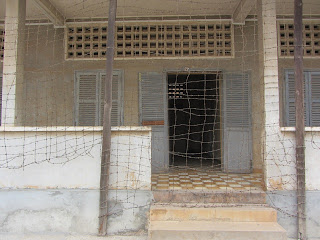 |
| Faces on the southern gate of Angkor Thom |
If you haven't already figured it out, the crowds should let you know. You are one of the 2 million tourists per year who visit this jaw-dropping complex. We decided to start off our Cambodia adventure with it's superstar: the Angkor temples.
If you think you can see it all in one day, you probably can, but you'll miss out on the whole idea of actually being here; imagining what it might have been like living here, how they built it, the craftsmen who created the amazing bas-reliefs, and just finding some beautiful detail at which to stare. In fact, we underestimated that we'd be able to see everything (yeah right, over 1000 temples!) in a few days. It's a lot. And it's hot (especially in March). And you'll be exhausted from all that walking. After those three days, you'll be looking at it all and think that it's just a pile of rocks, right? That's when temple overload has sunk in. How to combat temple fatigue? Take your time. And don't do back to back days. The multiple day passes are great in that you get a week for the 3 day one and a whole month for the 7 day.
With Alex in tow, we settled for 3 days of Angkor's offerings. Fortunately, we also hired a remork (think: motorbike pulling a semi-covered carriage), whose driver also doubled as a babysitter while we rambled through the ruins. This also made it much easier to linger and contemplate.
The Angkorian period started in the 9th century when the Jayavarman II declared himself the universal monarch or devaraja (god king). This notion of god king carried onto successive rulers up until the 15th century and drove the creation of these architectural wonders. Each one added to this amazingly large site until finally totaling this urban sprawl to 1000 square kilometers. Some researchers think that it may have even supported up to 1 million people. What happened to finally put this great city-state to an end? Some theorize that neighboring Siam invading, Buddhism taking over and eroding the cult of the god king, while some believe that neglect of public works such as the irrigation system for the rice fields (due to wars) led to it's abandonment.
It was not until the late 19th century that Angkor was rediscovered by French archeologists and restoration began. Up until today, you'll find sites still being uncovered and new artifacts being catalogued.
Here are my top pics:
1. The Bayon
We spent a whole morning just staring and discovering more and more bas-reliefs. The range of depth in the reliefs make it appear as if they were going to leap out at you. Everyday life on the bottom and a naval battle in the center on an outside wall, elephants, buffalo and other wildlife, and then on the inner wall with scenes of Hindu gods, well, we couldn't get enough. Then there are those towers, each with four Avalokitesvaras smiling at you. I could return to Angkor for this one temple alone.
2. Ta Prohm
Here nature takes center stage. Figs and silk trees eventually took over but during the restoration process they scaled back as many trees as they could without destroying the remaining temples. It's a delicate balance between exposing enough and keeping the tree that's holding the structure intact! Tomb Raider (the movie) fans will be happy to know that Angelina's character, Lara Croft, met the mysterious girl right here in Ta Prohm.
3. Kbal Spean
This is a must visit simply to take a shady hike to a riverbed full of reliefs. They
call this "The River of a Thousand Lingas." Rightfully so, there are
short stubby lingas, Shivas and Vishnus carved out of the rocks in a 150 meter stretch of river, ending in a refreshing waterfall. To get there, you take a taxi, remork or moto 25 km outside the main Angkor site. The ride through the countryside will take you to a large palm sugar producing area where you can sample some fresh palm sugar candy and see part of the process.
4. Banteay Srei
On the way back from Kbal Spean we ended the day with this 10th century temple. This is commonly known as the "Citadel of Women or Beauty" due to the delicate and intricate nature of the carvings on red sandstone of this small group of temples. We didn't get to stay for the orange glow this apparently takes at sunset, but they're gorgeous no matter what time of day. It's one of my favorite styles in all of Angkor.
At the end of the day when you think you can't possibly see any more, you should take a break and cool off at Frangipani Villa Siem Reap. Here's Alex, poolside:
Tomorrow, get up early and start again! There's never enough time to see all of Angkor. We'll definitely be making a return trip here to make another attempt.























































